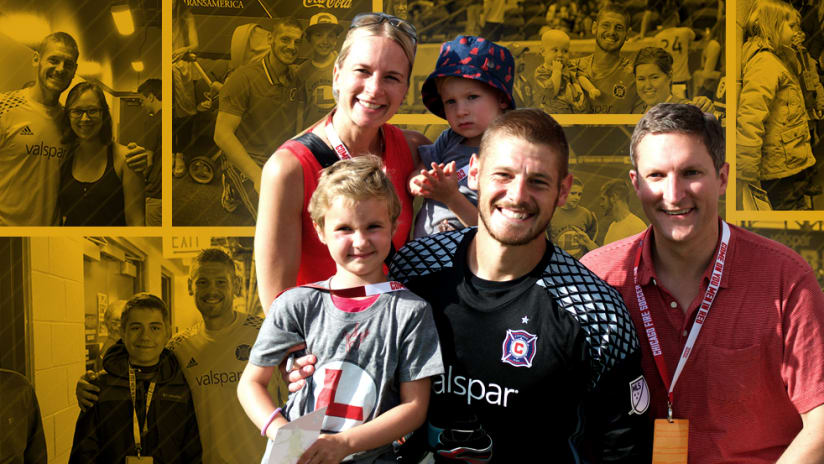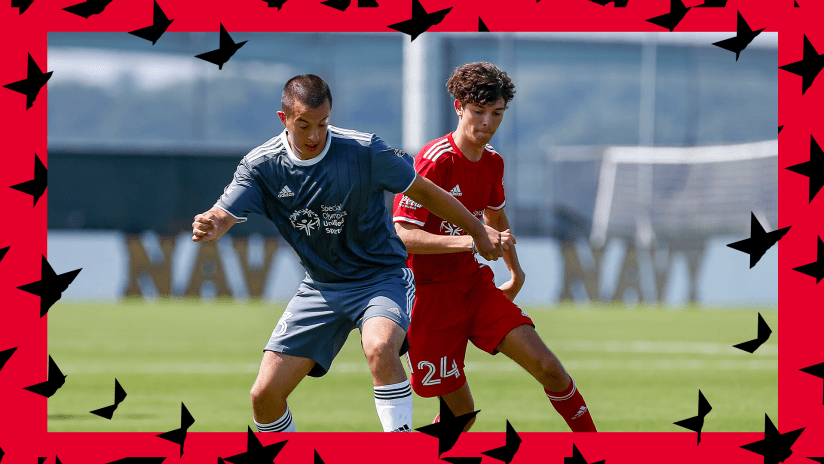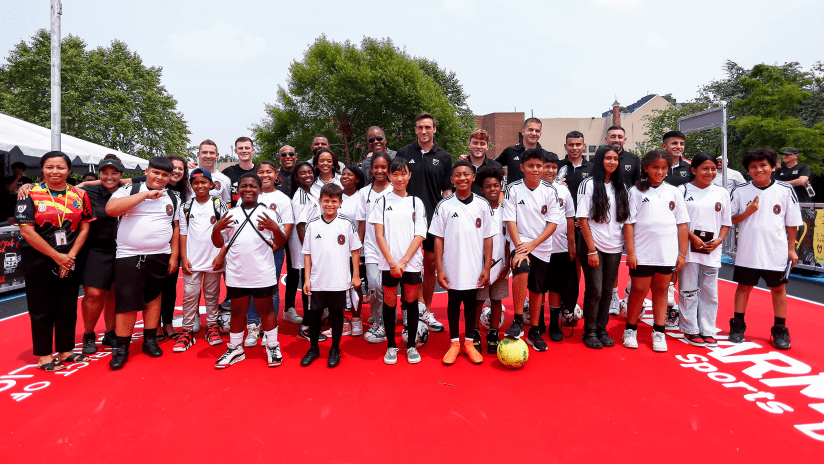Matt Lampson wasn’t the perfect cancer patient.
If he wanted ribs or a burger against the instruction of his nurse practitioner – charred meat is a no-no for cancer patients – Lampson ate them anyway. Not every day, of course, but he never wanted to forget that his life was more than the disease.
It wasn’t that Lampson was completely carefree or outright dismissive about his treatment, he just wasn’t going to let cancer dictate his life.
“Don’t act like you’re dying,” he says, “act like you want to live afterward.”
It’s the same message the 27-year-old Chicago Fire goalkeeper delivers to cancer patients and survivors nearly a decade after his own diagnosis.
“I know so many people that go though cancer treatment and they’re overly strict,” Lampson says. “I guess it’s up to them because your life is your life. If you’re too loose with things, maybe something happens. I kind of feel sorry for them because I want to be like, ‘Yeah, be serious about everything, but try to enjoy your life as much as you can while you’re going through it. As much as it sucks, try to get some happiness out of it.’”
It’s been nearly nine years since Lampson, then a high school senior, was diagnosed with Stage 4B Hodgkin’s lymphoma. Today, he’s cancer free.
On the field, he’s in the middle of his fifth professional season, battling for a starting spot with the Chicago Fire. Off the field, his foundation, LampStrong, provides support to cancer patients and their families. Cancer will always be a part of who he is, but it doesn’t define him.
“I am who I am now,” Lampson says. “I’ve grown so much as a professional, as a soccer player, as a person. I don’t want cancer to personify me. I want what I do afterward to be remembered not by, ‘Oh, that’s the cancer goalie.’ I want it to be, ‘Wow, he’s a very good goalkeeper. I can’t believe he had cancer, too.’”
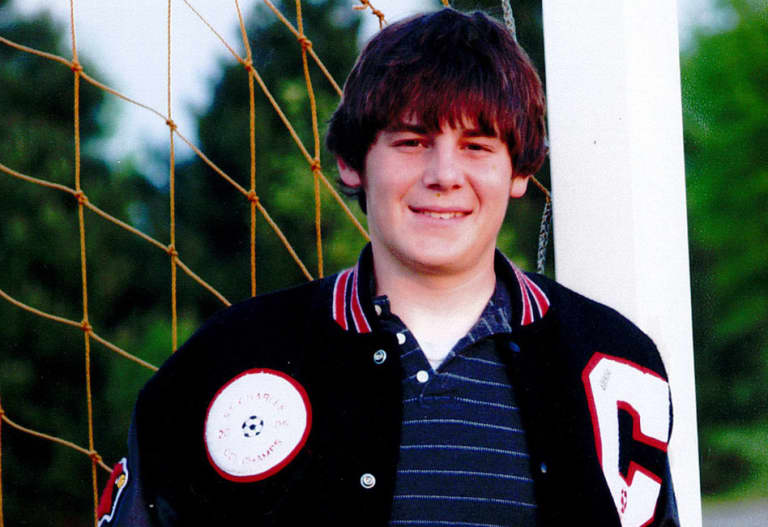
This photo, for Lampson's high school graduation announcements, was taken about two months before he was diagnosed with Stage 4B Hodgkin's lymphoma. He was headed to Northern Illinois to attend college and play soccer that fall. Photo via Mecy Lampson
LAMPSON WAS TRYING TO SAVE other lives when he learned his own life was in jeopardy.
In March 2007 – late in his senior year at St. Charles Preparatory in Columbus, Ohio – Lampson decided to donate blood. Like everyone else volunteering, his hemoglobin levels, a protein molecule in red blood cells, were tested to ensure he was a viable donor.
He wasn’t. His hemoglobin levels were too low. When he got home, Lampson told his father Christopher, a cardiac anesthesiologist, and his mother Mecy, a nurse, what had happened. They knew that was out of the ordinary for a healthy 17-year-old. They pressed their son to see a doctor despite his resistance.
“To make an appointment was a big to-do,” Mecy says. “He was pissed. He was so angry. He said, ‘You’re over-exaggerating. It’s nothing.’”
Lampson eventually relented. Before the appointment, he asked his father to take a look at a golf ball-sized lump on the side of his neck. Lampson made a “morbid” joke about the growth; Christopher immediately knew something was wrong.
“I was like, ‘Look at the cancer on my neck,’” Lampson remembers. “Thinking about it now, it’s pretty sadistic. At the same time, I’m pretty low key. I’m lighthearted. I don’t take things like that too seriously.”
Lampson was first prescribed an antibiotic, but that had no effect on the lump. He underwent further tests. The waiting was so stressful for his parents that Christopher reached out to a friend who was a surgeon and asked for a favor: Would he perform a biopsy on Lampson’s lymph nodes?
On June 10, 2007, Christopher and Mecy got the news. It wasn't good. Lampson had Stage 4B Hodgkin’s lymphoma, complete with a five-year survival rate of 65 percent according to the American Cancer Society. The disease was advanced. There was a large tumor in his chest.
Christopher and Mecy kept the news to themselves, for the time being. Lampson was scheduled to attend orientation at Northern Illinois University, where he was also planning on playing soccer. They thought it better to let him enjoy the experience without a cloud hanging over his head.
“We were both crying and it was terrible,” Mecy remembers. “My husband said he’s going to take him. I said I’m going to take him. I took him. We didn’t tell him at that point because we didn’t want to ruin something for him if that was the last something he was going to do.”
Of course, they couldn’t keep their son in the dark forever. When Lampson came back to Columbus, Christopher broke the news.
“I was on the computer, turned around and said to my dad just nonchalantly, not even thinking, ‘Whatever happened with the tests we had?’” Lampson says. “And he goes, ‘Well, we need to talk about that.’ My heart dropped because obviously I was like, ‘What does that mean?’ So he said, ‘You have cancer. You have Hodgkin’s lymphoma.’
“My immediate thought – I didn’t necessarily think of anything else – I just said, ‘Well, what do I have to do to beat it?’”
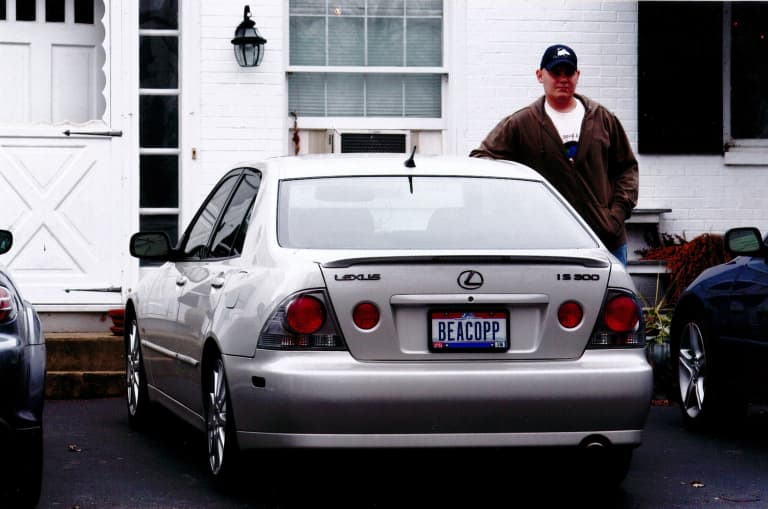
After four grueling rounds of chemotherapy and the disease ostensibly licked, Lampson was in no hurry to subject himself to more misery. Turning down additional rounds that might further reduce the chance of recurrence was an easy decision. But his parents were insistent, and a Lexus sedan helped persuade him to undergo the treatment. Photo via Mecy Lampson
LAMPSON DIDN'T MENTION THE CAR. His mother did.
The car is a silver 2004 Lexus IS 300. It’s what Lampson’s parents bribed him with to undergo two additional rounds of chemotherapy to help eradicate the disease that had invaded his lungs, pancreas and bones and left a tumor as big as a fist lodged inside his chest.
“They told you about the car? Oh, God,” Lampson says. “I’ll tell you right now it was not worth it to this day. It’s a constant reminder of what I had to do for it. It was not worth having to do two more rounds of chemotherapy. Absolutely not. If I could go back and refuse two more rounds, I would do it in a heartbeat.”
After his first two rounds of chemotherapy, Lampson was deemed cancer free. He then underwent two more rounds to reduce scar tissue. But when his scar tissue hadn’t shrunk as much as everyone hoped, further chemotherapy was recommended to guarantee the cancer wouldn’t return.
Lampson declined the recommendation. He had turned 18 on Sept. 6, 2007, and such decisions were now up to him. He'd already endured four rounds of a regimen called BEACOPP (Bleomycin, Etoposide, Adriamycin, Cyclophosphamide, Oncovin, Procarbazine, and Prednisone), cancer drugs he can rattle off with the speed and verbal dexterity of an auctioneer.
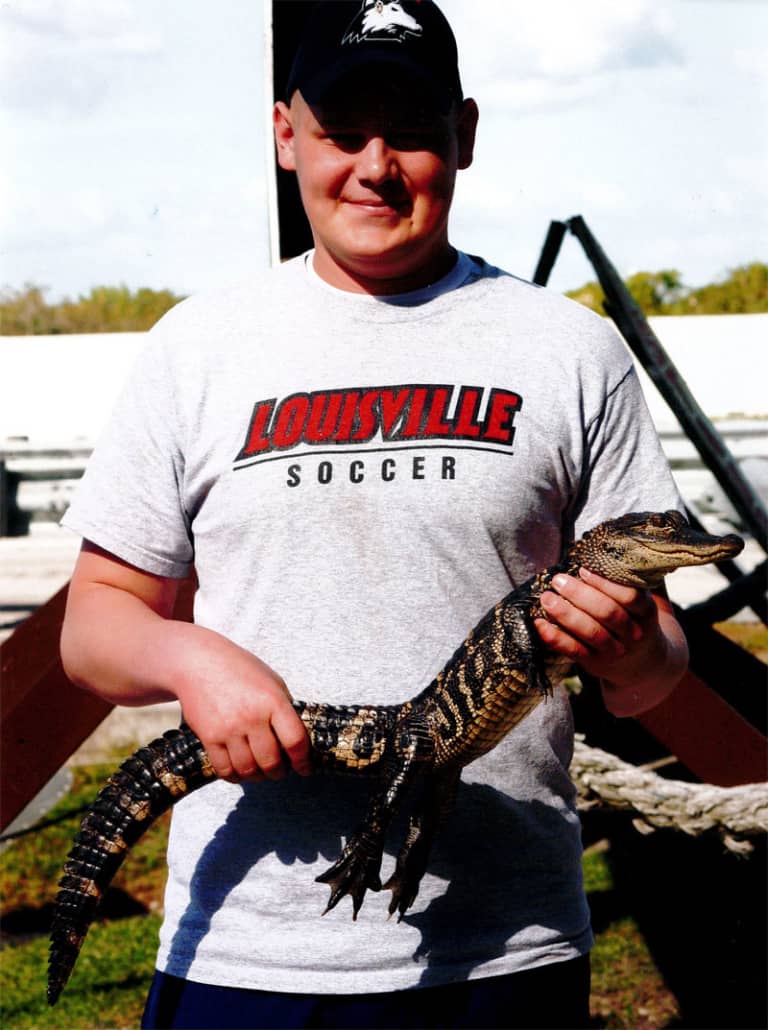
Following a sixth and final round of chemotherapy, the Lampsons visited family in Florida in Dec. 2007, including a trio to the Everglades. Matt had gained 100 pounds during the "brutal" treatment process. On Sept. 6, 2007, Lampson's 18th birthday, he was undergoing chemotherapy treatment. (Courtesy of Mecy Lampson)
Doctors in the United States have since moved away from BEACOPP in recent years, favoring chemotherapy regimens that aren’t so taxing on their patients.
“This chemotherapy regime was brutal,” Lampson says. “I say this to guys now within the cancer community, ‘Oh, yeah, I got BEACOPP,’ and it’s like, ‘Holy [crap]. I can’t believe it.’ Like my siblings too, they’re like, ‘I can’t believe you got BEACOPP.’ It was pretty damn miserable.”
One round of BEACOPP lasts three weeks. Drugs are administered on some days, and the body recovers during the others. The patient takes a licking throughout.
“Basically, it just kills you to save your life,” Lampson says. “It sucks. Everything about you is getting killed, not just the cancer cells. … You’re just tired all the time because all those red blood cells are getting killed. White blood cells, I couldn’t be around other people because I had no means of fighting off any infections. A simple cold can turn into pneumonia and then you’re gone. That’s one round. I was scheduled for four.”
Christopher and Mecy encouraged their son to consider doing the two more rounds just to be safe. He couldn’t imagine going through that cycle two more times. Finally, an agreement was made. His parents would buy him a used Lexus if he agreed to undergo more chemo. A contract was drafted, and Lampson signed on the dotted line.
“It tore us up,” says Mecy, who was at her son’s side throughout his hospital stays and cared for him and administered IVs at home. “We couldn’t force him because he was 18. We couldn’t make him do it unless we went to court. You really would have done anything for him to do something. It’s been a good result.”
The Lexus has also been a good car. Lampson still drives it today, even if he doesn’t believe it was worth the price he paid. Ultimately, the scar tissue stayed the same.
“I like to take care of it,” he says. “I want to make sure it lasts as long as I do."
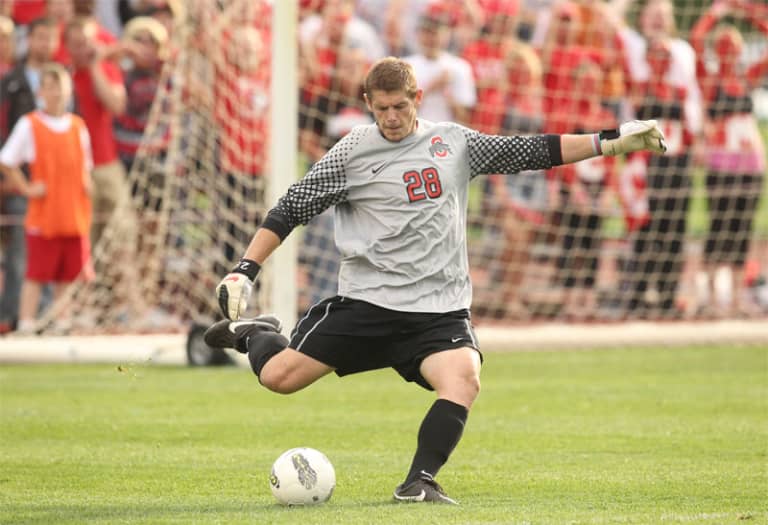
Cancer derailed his collegiate soccer career at Northern Illinois, but Lampson didn't give up on his dream. He began as Ohio State's fourth goalkeeper and finished his Buckeyes career as a three-time all-conference selection. Photo via Ohio State Athletics
ON SEPT. 24, 2007 – 471 days after Christopher and Macy had learned their son had Stage 4B Hodgkin’s lymphoma – Lampson and his mother were told his latest scan showed no signs of cancer.
Mecy burst into tears. The nurse practitioner followed. Matt didn’t react.
“I was like, ‘Cool,’” Lampson says. “It kind of sounds arrogant, but I just wanted to be like, ‘I know. That’s what I’m here for. That’s what I’m getting treated for.’ Positivity was good with me.”
After months of chemotherapy and radiation, Lampson looked and felt nothing like his prior self.
He was bald. He was weak. He was overweight, gaining nearly 100 pounds, up to 270, thanks to the anabolic steroids he was taking. He dreamed about playing soccer again, but the current state of his body made it seem like a long shot.
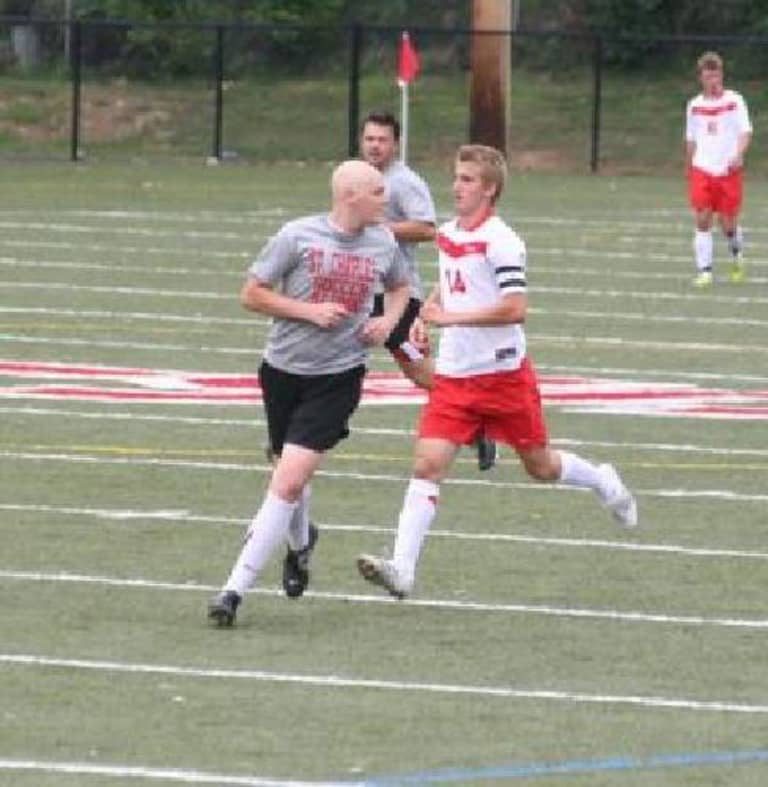
Lampson often dropped by training at his high school alma mater, St. Charles Preparatory. Mostly he just hung out and watched, but sometimes he hit the field against the advice of his medical team. (Courtesy of Mecy Lampson)
Lampson hadn’t completely abandoned soccer during his treatment. From time to time, when he was feeling up to it, he’d stop by St. Charles Preparatory and check out his former high school team, even attempting to train with them occasionally.
“He spent a lot of time with us,” says Rick Ey, who was the St. Charles head coach at the time. “He came to practices and to games. He came to our events. It seemed to me he was appreciating something to be a part of. He was caught in limbo. He was so successful in high school and was ready to jump to the next level. All of a sudden he was stuck. I like to think it helped him to stay positive to stick around things. He had the support from his coaches and support from his former teammates. I remember him hugging guys at end-of-year banquet. We recognized him as being part of the team.”
Lampson knew being out on a soccer field, like the occasional rack of ribs or flame-broiled cheeseburger, wasn’t what was best for him. He couldn’t help himself. He wanted to live. Cancer couldn’t deny him that.
“[The doctors] would never want me to play soccer,” Lampson says. “That would be the last thing they’d want me to do. They’d be like you can’t be out on a grass and turf field with germs and stuff like that and a bunch of other guys all around. You’re exposing yourself to too much.
“Well, I wanted to play soccer, and it made me happy. Being a positive mindset the whole treatment time was because of things like soccer. All I wanted to do was be able to play soccer again. I just wanted to be normal. I never in my wildest dreams would have been like, ‘Well, I’ll probably play pro when I’m done with treatment.’ I just wanted to go play at NIU. I just wanted to go play college soccer. Without soccer, I’d probably be, I don’t know, lame. I’d be really lame.”
Lampson’s progression from a mutant – his own description – to a professional goalkeeper took time. He trained with his old high school team. He joined the Columbus Crew SC academy in the spring of 2008. He wasn’t able to get through a warmup his first time on the field, but gradually gained strength and stamina.
Lampson went back to Northern Illinois the following year, but he couldn’t pass the team’s fitness test and remained on the sideline. Stomach ulcers, a side effect from his treatment, kept him from eating much. His weight fell to 170 pounds.
He needed to be closer to home and the medical staff that knew his history. Lampson wasn’t giving up soccer, though. He contacted Ohio State coach John Bluem and asked if he could join the Buckeyes. Bluem said the team could use a fourth goalkeeper.
At Ohio State, everything changed for Lampson. He felt better. His soccer career took off. He won the Buckeyes starting the job by the spring. He was happy again.
“When I went to Ohio State, that’s when I really started to appreciate things,” Lampson says. “Cancer made me a much better person and a much better goalkeeper because things that most people take granted I really had perspective on.
“Most people go to college and party their lives away, and here I am I just finished fighting for my life. I had to mature a lot quicker than most people did. You figure out who your friends are. You figure out what your priorities are, what your values are really quickly. I think that helped me on the soccer field. It made me want to be the best I could be every training session."
Lampson played 56 games for the Buckeyes, recording a 0.86 goals-against average with 24 shutouts and earning all-conference accolades in all three seasons he played at Ohio State. In December of 2011, he signed with Crew SC as a Homegrown player. His family are season-ticket holders since 1996.
“I don’t think I’m surprised,” Ey says. “It’s what he wanted to do. If he wants to be surgeon, he’s going to be a surgeon. If he wants to be a biological researcher, he’s going to do that. If he wants to be a professional goalkeeper, he’s going to do that. Am I surprised? He never gave me reason to doubt that. It was cancer. It was a very big deal, but he’s stronger than that.”
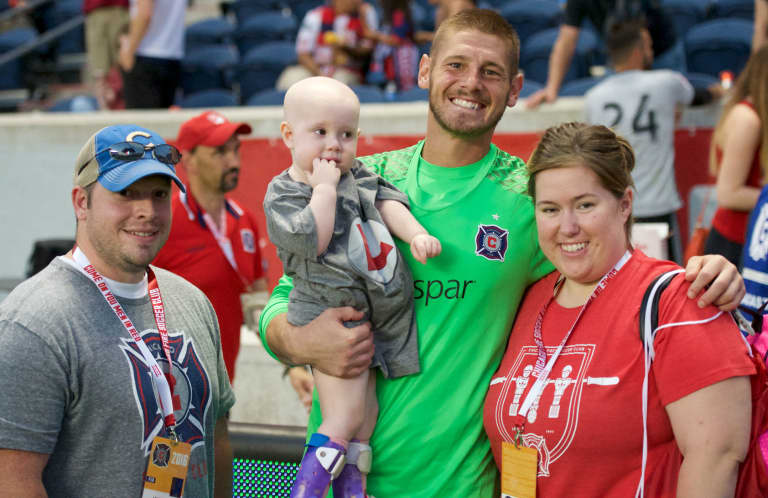
The LampStrong Foundation provides support to cancer patients and their families. Lampson often invites patients, children he calls Heroes, and their families to Fire games. Photo via Chicago Fire
FAYE WILLEN KNOWS SHE CAN ALWAYS COUNT ON LAMPSON. She was his nurse practitioner at Columbus’ Nationwide Children’s Hospital while he underwent treatment and has plenty of patients who could benefit from learning about that journey from the man himself.
And Lampson’s not just willing to help cancer patients and survivors. He seeks out those opportunities. It hasn't always been that way.
“Some people who get through the treatment want to get on with their life,” says Willen. “They don’t want to talk to other people. They don’t want to reach out. Not for selfish reasons, they want to move on. You never push. It’s painful enough physically and emotionally. He was someone who could reach that responsibility level.
“In fact, I have kind of called him out on that a little bit over the years. [Because of] the person he is I’ve tapped into him and his responsibility level. I knew he was somebody who could give back. He’s done so 10 times.”
At first, Lampson didn’t want to talk about his diagnosis or treatment for a few years. Eventually, though, he opened up and saw an opportunity to help out. At first, his contributions were small. In time, his desire was to make an even greater impact.
In 2014, he founded the LampStrong Foundation in order to provide financial, educational, emotional and motivational support to cancer patients, survivors and their families. He holds fundraisers. He hosts cancer patients, children he calls Heroes, and their families at MLS games.
With the help of Nationwide Children’s Hospital, where he underwent treatment, the LampStrong Foundation organizes meetings and events that provide adolescents and young adults dealing with a cancer diagnosis or adjusting to life after treatment, along with their families, a forum.
“It’s an invaluable resource because people are realistic. They know what they’ve done,” Lampson says. “They can talk to other people about what they should expect, what they’re going through, what they might go through. That’s another thing we really like to focus on. That’s one of my favorite groups to bring out as LampStrong Heroes. They understand what they can do after treatment.”
Lampson has plenty of experience and knowledge to draw upon. If soccer didn’t work out for him, he was going to follow his parents and older siblings into medicine. His brother Ben is an oncologist, his sister Mallory is a perfusionist and his other sister Erin is a pediatric oncologist. Lampson jokes that he’s the “failure” of the family.
“Whether he knows it, he’s definitely a role model for these kids,” says Erin, who acknowledges her brother’s experience helped determine what sort of doctor she would become. “There were kids who wrote him letters when he was going through treatment in Columbus. ‘You’re my favorite player. I want to be like you.’ These kids really looked up to him like an inspiration. To be able to honor them as LampStrong Heroes is really, really exciting because I think it gives these kids hopes and direction that they can accomplish their goals, too.”
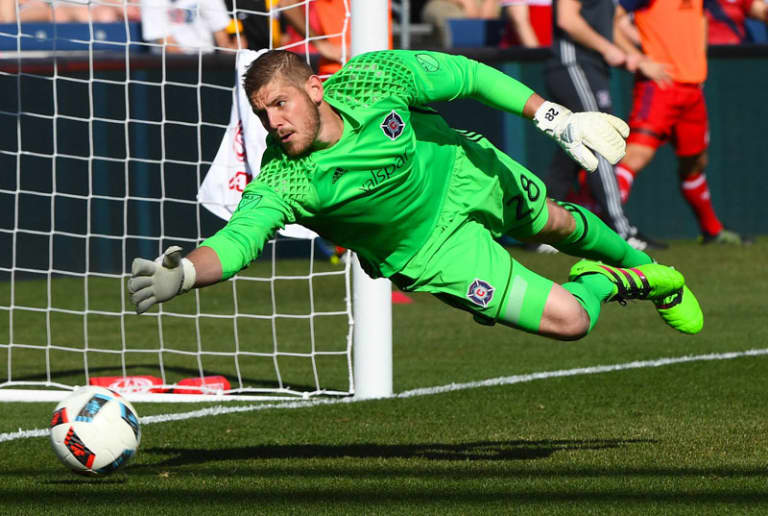
After bidding his time in Columbus, Lampson landed in Chicago in 2016 and promptly won a starting spot with the Fire. Though Sean Johnson eventually wrestled it back, the 27-year-old has made 11 starts following consecutive seasons without a regular-season appearance. Photo via USA Today Sports Images
SOCCER HASN'T ALWAYS BEEN AN UNINTERRUPTED LOVE AFFAIR for Lampson. There have been lulls.
One stretch was when he couldn’t play while undergoing his cancer treatment. The other came the past few seasons when he rode the bench for Crew SC. After starting 13 games for Columbus in 2013, Lampson didn’t play in a single minute in 2014 and 2015, two years he calls the hardest of his professional career.
As tough as that period was for Lampson, it’s made him grateful for his current opportunity even more. Nothing was guaranteed when he joined the Fire for training camp, but he won a roster spot during the preseason and then was named Chicago’s starter. He started the first nine games of the season for the Fire, but has backed up Sean Johnson since the middle of May, making two spot starts, in what has been a tough season in the Windy City.
“I think that’s one of the things that sets me apart is every single time I step on this field it’s surreal to me,” Lampson says. “I love playing soccer. Unlucky for me in Columbus the past two years, I didn’t even play a game. One of the first things I told my agent and my family after I played here was, ‘I forgot how fun soccer is to play.’ It really is. It’s an incredible thing. I’m lucky and blessed to be able to do it for a living. I appreciate things like this so much more now because I know how valuable life is, how easily it can switch right away.”
The cancer is gone, but there are still reminders. Lampson can’t run for very long, for one. He laughs and says he’s fortunate to be a goalkeeper. There’s a possibility his heart, lungs and thyroid will deteriorate with time. There’s a chance he’ll need to have his thyroid removed in his 40s.
Lampson wants to accomplish even more on and off the field in the coming years. He wants to get involved in Chicago’s cancer community and continue to grow his foundation. He wants to live his own message.
“Whenever I do a lot of speeches at cancer functions, the biggest thing that I harp on is using your second chance at life to really make a difference, to be someone that makes a difference in life and makes the most of your life,” Lampson says. “Especially with cancer survivors, people with close connections to cancer, who lost people to cancer, they realize how precious their life is they should do something.
“Just beating cancer isn’t enough. It’s an incredible accomplishment, an incredible feat, but it should pale in comparison with what you can now do with that second chance.”
THE WORD is MLSsoccer.com's regular long-form series focusing on the biggest topics and most intriguing personalities in North American soccer. Check out THE WORD archive.

